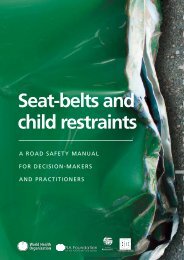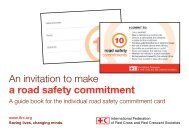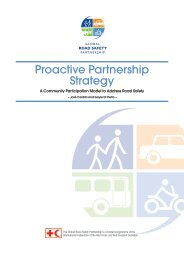How to design and implement a drinking and driving programme pdf ...
How to design and implement a drinking and driving programme pdf ...
How to design and implement a drinking and driving programme pdf ...
Create successful ePaper yourself
Turn your PDF publications into a flip-book with our unique Google optimized e-Paper software.
Drinking <strong>and</strong> Driving: a road safety manual<br />
3.4.1 <strong>How</strong> <strong>to</strong> raise public awareness <strong>and</strong> change attitudes through a<br />
mass media campaign<br />
A mass media campaign can be an effective <strong>to</strong>ol <strong>to</strong> educate the public about the risks<br />
of <strong>drinking</strong> <strong>and</strong> <strong>driving</strong>. The most effective road safety campaigns have been those<br />
that achieve a change in behaviour. It is of course also important <strong>to</strong> increase awareness<br />
<strong>and</strong> improve attitudes, but lives are actually saved when the desired behaviour<br />
patterns are adopted.<br />
New forms of behaviour can often be best achieved when legislation is backed up by<br />
enforcement <strong>and</strong> information. When strong legislation is in place, it is much easier <strong>to</strong><br />
persuade people of the value of not <strong>drinking</strong> <strong>and</strong> <strong>driving</strong>. Issuing penalties can even<br />
be held back in the early stages while people realize that the rules are being enforced.<br />
Conducting a mass media campaign requires expertise in marketing or advertising,<br />
development of specific campaign objectives, articulation of the campaign messages<br />
<strong>and</strong> the target audience, specifying a timeframe for <strong>implement</strong>ation, <strong>and</strong> a methodology<br />
for evaluating this initiative.<br />
Selecting an agency for the campaign<br />
A successful campaign may be carried out by qualified personnel within a government<br />
department, but usually needs the expertise of a professional marketing or<br />
advertising agency. Overall control of the campaign should, however, stay with the<br />
government agency responsible. The campaign may also require the services of a<br />
public relations or advertising agency <strong>and</strong> a research agency, unless the government<br />
agency can provide these services itself.<br />
The first step in selecting an agency is <strong>to</strong> issue a tendering document, outlining the<br />
overall aims <strong>and</strong> objectives of the campaign, the time schedule <strong>and</strong> the budget. From<br />
their initial applications, a shortlist of agencies should be drawn up, based on:<br />
•<br />
•<br />
•<br />
•<br />
•<br />
the agencies’ previous experience with social marketing campaigns;<br />
their creative ability;<br />
their physical location;<br />
their media purchasing ability;<br />
their size.<br />
These agencies are then asked <strong>to</strong> tender for the work, by providing creative ideas,<br />
plans for media work <strong>and</strong> budgets.<br />
3 | <strong>How</strong> <strong>to</strong> <strong>design</strong> <strong>and</strong> <strong>implement</strong> a <strong>drinking</strong> <strong>and</strong> <strong>driving</strong> <strong>programme</strong><br />
Setting objectives for the campaign<br />
The most important aspect of any campaign is <strong>to</strong> have a clear idea of what the<br />
campaign is meant <strong>to</strong> achieve. The objectives may be stated in quantifiable terms.<br />
For instance, the public might be <strong>to</strong>ld that “by date X a BAC law of 0.05 will<br />
be introduced”.<br />
99
















